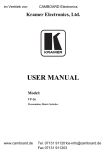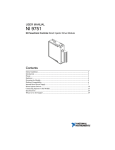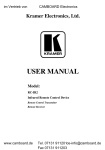Download USER MANUAL - Kramer Electronics
Transcript
Kramer Electronics, Ltd. USER MANUAL Model: VP-23RC Presentation Switcher / Controller Contents Contents 1 2 2.1 3 3.1 Introduction Getting Started Quick Start Overview About the VP-23RC 1 1 1 3 3 3.1.1 3.1.2 3.1.3 Understanding the Presentation Switcher Section Understanding the Media / Room Controller Section Controlling the VP-23RC 3 4 5 3.2 3.3 3.4 4 4.1 4.2 4.3 5 6 6.1 6.2 6.3 7 7.1 Connecting the VP-23RC Rear Panel Recommendations for Achieving the Best Performance Terminology Used in this User Manual Your Presentation Switcher / Controller The VP-23RC Front Panel The VP-23RC Rear Panel The VP-23RC Underside Panel Installing the VP-23RC on a Rack Connecting the VP-23RC Presentation Switcher Section Connecting the Balanced/Unbalanced Stereo Audio Input/Output Wiring the CAT 5 LINE OUT RJ-45 Connector Shielded Twisted Pair (STP) / Unshielded Twisted Pair (UTP) Connecting to the Media / Room Controller Equipment Setting the Media / Room Controller PROGRAM Dipswitches 6 7 7 8 8 10 13 14 15 17 18 18 19 21 7.1.1 Factory Reset 21 8 8.1 Controlling the VP-23RC Controlling the VP-23RC via a PC 22 22 8.1.1 Connecting an RS-232 port to a PC 23 8.2 Controlling Additional Kramer Machines via RS-232 and RS-485 24 8.2.1 The Presentation Switcher Section Dipswitches 24 8.3 Controlling via the ETHERNET 25 8.3.1 8.3.2 8.3.3 Connecting the ETHERNET Port directly to a PC (Crossover Cable) 26 Configuring Your PC 26 Connecting the ETHERNET Port via a Network Hub (Straight-Through Cable) 27 9 9.1 9.2 9.3 Operating Your VP-23RC The Front Panel Buttons Configuration of the VP-23RC Media / Room Controller Section Operation 28 28 29 29 9.3.1 9.3.2 9.3.3 Operating the Media / Room Controller An Example of Operating the VP-23RC Using the Media / Room Controller Macro Buttons 32 33 33 i Contents 9.3.4 Turning the Light of the Backlit Buttons On and Off 34 9.4 The Presentation Switcher Section Operation 34 9.4.1 9.4.2 9.4.3 The Independent Switchers Mode The Master Audio Mode The Presentation Switcher SELECTOR Buttons Macro Sequence 34 35 37 10 10.1 Flash Memory Upgrade Flash Memory Upgrade for the Presentation Switcher Section 38 38 10.1.1 Downloading from the Internet 10.1.2 Connecting the PC to the RS-232 Port 10.1.3 Upgrading the Firmware 38 38 39 10.2 Flash Memory Upgrade for the Media / Room Controller Section 43 10.2.1 10.2.2 10.2.3 10.2.4 Downloading from the Internet Connecting the PC to the RS-232 Port Upgrading Firmware Installing the Web Applet 43 43 44 44 10.3 11 12 12.1 13 Troubleshooting Firmware Upgrade Issues Technical Specifications Hex Table Audio Gain Control Hex Tables Communication Protocol 45 46 47 47 49 Figures Figure 1: VP-23RC Configuration Example Figure 2: VP-23RC Presentation Switcher / Controller – Front View Figure 3: VP-23RC Presentation Switcher / Controller – Rear View Figure 4: VP-23RC Presentation Switcher / Controller – Underside View Figure 5: Connecting the VP-23RC Presentation Switcher Section Figure 6: Connecting the Balanced Stereo Audio Input/Output Figure 7: Connecting the Unbalanced Stereo Audio Input Figure 8: Connecting the Unbalanced Stereo Audio Output Figure 9: CAT 5 PINOUT Figure 10: Connecting the VP-23RC Media/Room Controller Section Figure 11: Connecting a PC without using a Null-modem Adapter Figure 12: Default Dipswitch Settings Figure 13: Control Configuration via RS-232 and RS-485 Figure 14: Local Area Connection Properties Window Figure 15: Internet Protocol (TCP/IP) Properties Window Figure 16: Example of a Typical Media/Room Controller Section Configuration Figure 17: Example of a Typical Setup in the Lecture Auditorium Figure 18: Labels Setup Figure 19: VP-23RC Operation Example Figure 20: Separate Switcher Mode Figure 21: Switching in the Master Audio Mode Figure 22: Presentation Switcher Macro Sequence Example Figure 23: Splash Screen ii 6 9 11 13 16 17 17 17 18 20 23 24 25 26 27 30 31 32 33 35 36 37 39 KRAMER: SIMPLE CREATIVE TECHNOLOGY Contents Figure 24: Atmel – Flip Window Figure 25: Device Selection Window Figure 26: Selecting the Device from the Selection Window Figure 27: Loading the Hex Figure 28: RS-232 Window Figure 29: Atmel – Flip Window (Connected) Figure 30: Atmel – Flip Window (Operation Completed) Figure 31: The KFR-Programmer Window 39 40 40 41 41 42 42 44 Tables Table 1: Terminology Used in this User Manual Table 2: Front Panel VP-23RC Presentation Switcher / Controller Features Table 3: Rear Panel VP-23RC Presentation Switcher / Controller Features Table 4: VP-23RC Underside Panel Features Table 5: CAT 5 PINOUT Table 6: PROGRAM Dipswitch Settings Table 7: Connecting an RS-232 Port to a PC Table 8: Dipswitch Settings Table 9: Connection Scheme (for the example in Figure 16) Table 10: The Commands Configuration Table 11: Technical Specifications of the VP-23RC Presentation Switcher / Controller Table 12: VP-23RC Hex Table Table 13: VP-23RC Master Audio Selector Hex Table Table 14: Set the Audio Output Gain Control for the Groups Table 15: Set the Audio Output Gain Control for the Microphone Table 16: Set the Audio Output Gain Control for the Master Audio Table 17: Increase or Decrease the Audio Output Gain by One Step Table 18: Protocol Definitions Table 19: Instruction Codes 7 10 12 13 18 21 23 24 30 32 46 47 47 47 47 48 48 49 50 iii Introduction 1 Introduction Welcome to Kramer Electronics! Since 1981, Kramer Electronics has been providing a world of unique, creative, and affordable solutions to the vast range of problems that confront the video, audio, presentation, and broadcasting professional on a daily basis. In recent years, we have redesigned and upgraded most of our line, making the best even better! Our 1,000-plus different models now appear in 11 groups1 that are clearly defined by function. Congratulations on purchasing your Kramer VP-23RC Presentation Switcher / Controller, which is ideal for: Controlling multimedia rooms, such as classrooms, auditoriums, conference rooms and so on Production studios, rental and staging The package includes: VP-23RC Windows®-based Kramer control software and Kramer RC Configuration software Null-modem adapter, power cord2, and one 3.5mm to IR emitter control cable Kramer RC-IR2 Infrared Remote Control Transmitter (including the required batteries and a separate user manual3) This user manual3 2 Getting Started We recommend that you: Unpack the equipment carefully and save the original box and packaging materials for possible future shipment Review the contents of this user manual Use Kramer high performance high resolution cables4 2.1 Quick Start This quick start chart summarizes the basic setup and operation: 1 GROUP 1: Distribution Amplifiers; GROUP 2: Switchers and Matrix Switchers; GROUP 3: Control Systems; GROUP 4: Format/Standards Converters; GROUP 5: Range Extenders and Repeaters; GROUP 6: Specialty AV Products; GROUP 7: Scan Converters and Scalers; GROUP 8: Cables and Connectors; GROUP 9: Room Connectivity; GROUP 10: Accessories and Rack Adapters; GROUP 11: Sierra Products 2 We recommend that you use only the power cord that is supplied with this machine 3 Download up-to-date Kramer user manuals from our Web site at http://www.kramerelectronics.com 4 The complete list of Kramer cables is on our Web site at http://www.kramerelectronics.com 1 Getting Started 2 KRAMER: SIMPLE CREATIVE TECHNOLOGY Overview 3 Overview This section describes: Using shielded twisted pair (STP)/unshielded twisted pair (UTP) (see section 6.3) The VP-23RC (see section 3.1) Presentation Switcher section (see section 3.1.1) Media / Room Controller (see section 3.1.2) Means of control (see section 3.1.3) An example of how to connect the VP-23RC (see section 3.2) Recommendations for achieving the best performance (see section 3.3) Terminology used in this user manual (see section 3.4) 3.1 About the VP-23RC The VP-23RC is a high quality all-in-one Presentation Switcher and Media/Room Controller, which lets you control A/V equipment and room items such as window blinds, room lights, and a projector lift. The VP-23RC includes two major sections: the Presentation Switcher section and the Media/Room Controller section, each of which can be operated independently, or in tandem. 3.1.1 Understanding the Presentation Switcher Section The Presentation Switcher section includes three independent 4x1 audio/video switchers1, and a master audio switcher2. The VP-23RC Presentation Switcher section features: Three sets of four selector buttons (for composite video and audio, s-Video and audio, and VGA/UXGA and audio), and four master audio selector buttons (CV, s-Video, VGA/UXGA and Mic). Each of these 16 selector buttons lets you select the inputs to switch to the outputs and can be configured3 to carry out a sequence of up to 15 commands (a macro) so that when pressing a configured button, the switching action is followed by a macro sequence VGA/UXGA video bandwidth of 350MHz to ensure transparent performance even in the most critical applications, and is HDTV compatible Composite/SDI video bandwidth of 650MHz, an s-Video bandwidth of 385MHz, and a CAT 5 bandwidth of 158MHz 1 A 4x1 switcher for composite video and audio, a 4x1 switcher for s-Video and audio, and a 4x1 switcher for computer graphics (VGA/UXGA) signals with audio 2 That routes one of the pre-selected audio inputs (from these three switchers) to two separate outputs 3 By the system integrator 3 Overview Digital microphone input level control and digital master audio level control Microphone talk-over mode1 A CAT 5 output, with a transmission range of more than 300 feet (over 100 meters) that transmits VGA/UXGA signals2 to a remote acceptor via a receiver An internal 5-Watt per channel (24kHz, 3dB) power amplifier for connecting the speakers directly to the machine A panel LOCK button to prevent tampering with the front panel Recall of the previous setup from non-volatile memory Audio output level change (via RS-232) 3.1.2 Understanding the Media / Room Controller Section The Media/Room Controller section controls A/V equipment—especially projectors and associated equipment3—in media rooms (such as classrooms, boardrooms, or auditoriums), as well as room functions such as lights, blinds, a projector lift and/or a screen motor. The VP-23RC Media/Room Controller section includes: Eight configurable buttons to set up any supported commands An Ethernet port4 for configuration and control Two bidirectional RS-2325 serial ports for universal display (for example, projectors) and control of the VP-23RC (or other) switcher Four relays for the simplified and centralized control of room functions (such as lights, blinds, screen settings, and so on). The relays have normally open (NO) and normally closed (NC) contacts Three IR control ports An IR-learner for the customized remote transmitters, without the need for an external unit IR remote control Macro mode operation, for programming up to 15 commands with the press of a single button Firmware upgrade support 1 The microphone input signal lowers the line audio output level when the connected microphone detects sound 2 Excludes audio 3 Including the A/V equipment connected to the VP-23RC Presentation Switcher section 4 Also for controlling the Presentation Switcher section 5 The RS-232 terminal block port (item 14 in Figure 3) is also used for firmware upgrade 4 KRAMER: SIMPLE CREATIVE TECHNOLOGY Overview 3.1.3 Controlling the VP-23RC Control the VP-23RC using the front panel buttons, or remotely via: RS-2321 serial commands transmitted by a touch screen system, PC, or other serial controller The Kramer Infrared remote control transmitter The ETHERNET2 The VP-23RC is dependable, rugged, and fits into two vertical spaces (2U) of a standard 19” professional rack. 1 The RS-232 port (item 24 in Figure 3) located in the SWITCHER CONTROL area of the rear panel 2 The Ethernet port is located in the CONTROLLER area of the rear panel and is also used for configuration of the media/room controller section by the system integrator 5 Overview 3.2 Connecting the VP-23RC Rear Panel The VP-23RC can be connected in different configurations, integrating the Presentation Switcher section with the Media/Room Controller section. The block diagram in Figure 1 shows a VP-23RC configuration example: Relays IR Emitters RS-232 Figure 1: VP-23RC Configuration Example In this example: Three VIDEO sources are connected to the inputs The three VIDEO outputs are all connected to the same projector The projector is connected to the RS-232 port in the CONTROLLER area Two of the video sources are also connected to the IR terminal blocks A CAT 5 UXGA receiver is connected Various room items are connected to the RELAY terminal blocks A microphone and speakers are connected, as well as the audio inputs and outputs 6 KRAMER: SIMPLE CREATIVE TECHNOLOGY Overview To connect the VP-23RC as illustrated in the block diagram in Figure 1: Connect the A/V equipment1 to the Presentation Switcher section (see section 6) Connect the A/V equipment and room items to the Media/Room Controller section (see section 7) 3.3 Recommendations for Achieving the Best Performance To achieve the best performance: Connect only good quality connection cables, thus avoiding interference, deterioration in signal quality due to poor matching, and elevated noiselevels (often associated with low quality cables) Avoid interference from neighboring electrical appliances and position your Kramer VP-23RC away from moisture, excessive sunlight and dust 3.4 Terminology Used in this User Manual Table 1 defines some terms that are used in this user manual. Table 1: Terminology Used in this User Manual Term Definition The standard specification for ETHERNET that is maintained by the Institute of Electrical and Electronics Engineers (IEEE). Dynamic Host Allows the network administrator to distribute IP addresses from a central point and Configuration automatically send a new IP address when an Ethernet point is plugged into a different Protocol (DHCP) network location Gateway A network position serving as an entry to another network. On the Internet, a node or stopping point can be either a gateway node or a host (end-point) node. IP Address A 32-binary digit number that identifies each sender or receiver (within a network via a particular server or workstation) of data (HTML pages or e-mails) that is sent in packets across the Internet. Every device connected to an IP network must have a unique IP address. This address is used to reference the specific unit. Local Area Network Computers sharing a common communications line or wireless link, which often share a (LAN) server within a defined geographic area. Media Access A computer's unique hardware number (or address) in a LAN or other network. On an Control (MAC) Ethernet LAN, the (MAC) address is identical to the Ethernet address. Address Transmission The basic communication language or protocol of the Internet that breaks the message Control into appropriately sized packets for the network, and can be used as a communications Protocol/Internet protocol in an intranet or an extranet. Protocol (TCP/IP) 802.3 1 Such as DVD players, video players, speakers and so on 7 Your Presentation Switcher / Controller 4 Your Presentation Switcher / Controller The VP-23RC front and rear panels relate in the following way: The Presentation Switcher section relates to the AUDIO, VIDEO and SWITCHER CONTROL areas on the rear panel The Media/Room Controller section relates to the CONTROLLER area on the rear panel The Power connector, the RS-232 port in the SWITCHER CONTROL AREA and the ETHERNET port are common to both sections This section describes the VP-23RC: Front panel (see section 4.1) Rear panel (see section 4.2) Underside panel (see section 4.3) 4.1 The VP-23RC Front Panel Figure 2 and Table 2 define the front panel of the VP-23RC. 8 KRAMER: SIMPLE CREATIVE TECHNOLOGY Your Presentation Switcher / Controller Figure 2: VP-23RC Presentation Switcher / Controller – Front View 9 Your Presentation Switcher / Controller Table 2: Front Panel VP-23RC Presentation Switcher / Controller Features # 1 Feature IR (Infrared) Receiver 2 3 4 POWER Switch IR IN Receiver MEDIA / ROOM CONTROLLER Buttons s-VIDEO (Y/C)-AUDIO SELECTOR Buttons VIDEO (CV)-AUDIO SELECTOR Buttons VGA/UXGA-AUDIO SELECTOR Buttons CV Button 5 6 7 8 9 10 11 12 13 14 Function Signals from the Kramer remote control transmitter illuminate the LED Illuminated switch for turning the unit ON or OFF 1 Accepts IR remote commands for the IR learner feature 2 Control the room and the A/V equipment (from 1 to 8) 2 Selects the s-Video-audio source (from 1 to 4) 2 Selects the composite video-audio source (from 1 to 4) Selects the VGA/UXGA video-audio source from (1 to 4)2 Press to route the selected audio signal from the composite 3 video section to the master audio outputs s-VIDEO Button Press to route the selected audio signal from the s-Video 3 MASTER section to the master audio outputs AUDIO 2 VGA/UXGA Button Press to route the selected audio signal from the SELECTOR 3 VGA/UXGA section to the master audio outputs MIC Button Press to route the microphone input to the master audio outputs3 - Button Decrease the microphone audio signal level MIC + Button Increase the microphone audio signal level AUDIO LEVEL + Button Increase the master audio signal level MASTER - Button Decrease the master audio signal level LOCK Button Press to lock the front panel buttons TALK OVER Button Push the button to activate talk over4 4.2 The VP-23RC Rear Panel Figure 3 and Table 3 define the rear panel of the VP-23RC. 1 Used by the system integrator only, see section 9.2 2 Each button when pressed can also execute a macro sequence of up to 15 programmed commands (as configured by the system integrator) 3 MASTER OUT and SPKR OUT 4 With the TALK OVER button selected, speaking into the microphone amplifies the voice of the speaker, overriding and fading out all other audio channels. However, pressing the MIC button in the Master Audio Selector renders the Talk Over function inactive 10 KRAMER: SIMPLE CREATIVE TECHNOLOGY Your Presentation Switcher / Controller Figure 3: VP-23RC Presentation Switcher / Controller – Rear View 11 Your Presentation Switcher / Controller Table 3: Rear Panel VP-23RC Presentation Switcher / Controller Features Feature MIC IN Connector COND. / DYN Selector Switch 3 4 5 6 7 CV OUT Terminal Block Connector Y/C OUT Terminal Block Connector UXGA OUT Terminal Block Connector MASTER OUT Terminal Block Connector CV IN Terminal Block Connectors AUDIO # 1 2 17 18 19 20 21 22 23 24 25 26 27 28 VIDEO 15 16 SWITCHER CONTROL 12 13 14 Y/C IN Terminal Block Connectors UXGA IN Terminal Block Connectors SPKR OUT Terminal Block Connector RELAY Terminal Block Connector CONTROLLER 8 9 10 11 Function Connect to the microphone Push in to select a condenser, release to select a dynamic microphone Connect to the composite video balanced audio acceptor Connect to the s-Video balanced audio acceptor Connect to the VGA/UXGA balanced audio acceptor Connect the master balanced audio channel acceptor1 2 Connect to the composite video balanced audio sources 2 Connect to the s-Video balanced audio sources 2 Connect to the VGA/UXGA balanced audio sources Connect to a pair of loudspeakers 2 Connect each relay to a room item. The PINOUT is: NO: Normally Open; C: Common; NC: Normally Closed Connect to an IR emitter cable (from IR1 to IR 3) Connects to the PC through computer networking3 Connect to the RS-232 port of the A/V equipment or a PC or other Serial Controller IR Terminal Block Connectors ETHERNET Connector RS-232 Port 1:Terminal Block 4 Ports Connector (G, Rx, Tx) Port 2: 9-pin D-sub Connector PROGRAM Dipswitches DIP1 is for firmware upgrade (see section 10.2); DIP 3 is for factory reset; DIP 2 and DIP 4 are not used (see section 7.1) CV IN BNC Connectors Connect to the composite video sources2 CV OUT BNC Connector Connect to the composite video acceptor Y/C IN 4-pin Connectors Connect to the s-Video sources2 Y/C OUT 4-pin Connector Connect to the s-Video acceptor UXGA IN 15-pin HD Connectors Connect to the VGA/UXGA video sources2 UXGA OUT 15-pin HD Connector Connect to the VGA/UXGA video acceptor UXGA CAT5 OUT Connect to a remote computer graphics acceptor via a receiver (for example, the TP-120), see section 3.2 RJ-45 Connector Connect to a PC to control the VP-23RC RS-232 9-pin D-sub Port FLASH PROG. Button RS-485 Terminal Block Port Dipswitches Power Connector with Fuse Push in to upgrade the Presentation Switcher section to the latest Kramer firmware (see section 10.1), or release for Normal (the factory default) Pins B (-) and A (+) are for RS-485; Pin G may be connected to the shield (if required) DIPs 1, 2 and 3 are OFF, DIP 4 is ON for RS-485 termination AC connector enabling power supply to the unit 1 Both the MASTER OUT and the SPKR OUT terminal block connectors receive the same signal: the MASTER OUT outputs the signal as it is while the SPKR OUT is amplified 2 From 1 to 4 3 To configure the Media/Room Controller section or control the VP-23RC via the ETHERNET 4 Port 1 can connect to a PC to upgrade the firmware of the Media/Room Controller section 12 KRAMER: SIMPLE CREATIVE TECHNOLOGY Your Presentation Switcher / Controller 4.3 The VP-23RC Underside Panel Figure 4 and Table 4 define the VP-23RC underside features: RESET VS HS Figure 4: VP-23RC Presentation Switcher / Controller – Underside View Table 4: VP-23RC Underside Panel Features Feature RESET Button VS Switch HS Switch Function Press to reset the unit prior to firmware upgrade (see section 10.1) Slide the switch to the left (to NORMAL) to retain the polarity of the vertical sync pulses on the UXGA CAT5 OUT connector; slide the switch to the right1 to change the vertical sync pulses on the UXGA CAT5 OUT connector (VS) polarity to NEGATIVE polarity2 Slide the switch to the left (to NORMAL) to retain the polarity of the horizontal sync pulses on the UXGA CAT5 OUT connector; slide the switch to the right1 to change the horizontal sync pulses on the UXGA CAT5 OUT connector (HS) polarity to NEGATIVE polarity2 1 By default, both switches are set to the left 2 Downgoing syncs 13 Installing the VP-23RC on a Rack 5 Installing the VP-23RC on a Rack This section describes what to do before installing on a rack and how to rack mount. Before Installing on a Rack Before installing on a rack, be sure that the environment is within the recommended range: Operating temperature range +5° to +45° C (41° to 113° F) Operating humidity range 10 to 90% RHL, non-condensing Storage temperature range -20° to +70° C (-4° to 158° F) Storage humidity range 5 to 95% RHL, non-condensing How to Rack Mount To rack-mount a machine: 1. Attach both ear brackets to the machine. To do so, remove the screws from each side of the machine (3 on each side), and replace those screws through the ear brackets. CAUTION!! When installing on a 19" rack, avoid hazards by taking care that: 1. It is located within the recommended environmental conditions, as the operating ambient temperature of a closed or multi unit rack assembly may exceed the room ambient temperature. 2. Once rack mounted, enough air will still flow around the machine. 3. The machine is placed straight in the correct horizontal position. 4. You do not overload the circuit(s). When connecting the machine to the supply circuit, overloading the circuits might have a detrimental effect on overcurrent protection and supply wiring. Refer to the appropriate nameplate ratings for information. For example, for fuse replacement, see the value printed on the product label. 5. The machine is earthed (grounded) in a reliable way and is connected only to an electricity socket with grounding. Pay particular attention to situations where electricity is supplied indirectly (when the power cord is not plugged directly into the socket in the wall), for example, when using an extension cable or a power strip, and that you use only the power cord that is supplied with the machine. 14 2. Place the ears of the machine against the rack rails, and insert the proper screws (not provided) through each of the four holes in the rack ears. Note that: In some models, the front panel may feature built-in rack ears Detachable rack ears can be removed for desktop use Always mount the machine in the rack before you attach any cables or connect the machine to the power If you are using a Kramer rack adapter kit (for a machine that is not 19"), see the Rack Adapters user manual for installation instructions (you can download it at: http://www.kramerelectronics.com) KRAMER: SIMPLE CREATIVE TECHNOLOGY Connecting the VP-23RC Presentation Switcher Section 6 Connecting the VP-23RC Presentation Switcher Section To connect1 the VP-23RC Presentation Switcher section, as illustrated in the example in Figure 5, do the following2: 1. Connect the following video sources: One3 composite video source (for example, a composite video player) to the CV IN 1 BNC connector One3 s-Video source (for example, an s-Video player) to the Y/C IN 1 4-pin connector One3 VGA/UXGA source (for example, a computer graphics source) to the UXGA IN 1 15-pin HD connector 2. Connect the acceptors to a projector4 as follows: The composite video CV OUT BNC connector to the composite video input of the projector The s-Video Y/C OUT 4-pin connector to the s-Video input of the projector The VGA/UXGA UXGA OUT 15-pin HD connector to the VGA/UXGA input of the projector 3. Connect the appropriate balanced5 audio sources and acceptors (not shown in Figure 5). 4. If required, connect the MASTER OUT terminal block connector (not shown in Figure 5; see section 9.4.2). 5. Connect the SPKR OUT block connector to a pair of loudspeakers, by connecting the left loudspeaker to the “L+” and the “L-” terminal block connectors, and the right loudspeaker to the “R+” and the “R-” terminal block connectors. Do not Ground the loudspeakers. 6. Connect the UXGA CAT5 OUT twisted pair connector (see section 6.2) to a line receiver (for example, the TP-120 XGA Line Receiver6, which is connected to a remote display). 7. If required, connect a dynamic or a condenser microphone7 to the MIC IN XLR connector. 1 You do not need to connect all the inputs 2 Switch OFF the power on each device before connecting it to your VP-23RC. After connecting your VP-23RC, switch on its power and then switch on the power on each device 3 Although in this example only one source is connected, you can connect all of the four inputs, that is, 12 in total 4 In this example a projector is used, but you can also connect separate outputs such as displays or video recorders 5 To connect audio inputs and outputs, see section 6.1 6 The receiver receives the CAT 5 signal, decodes it and outputs it to a VGA acceptor 7 Use the Con / Dyn switch (refer to the rear panel, item 2 in Figure 3) to select a dynamic microphone or a condenser 15 Connecting the VP-23RC Presentation Switcher Section 8. If required, connect a PC to the RS-232 port (see section 8.1.1). Figure 5: Connecting the VP-23RC Presentation Switcher Section 16 KRAMER: SIMPLE CREATIVE TECHNOLOGY Connecting the VP-23RC Presentation Switcher Section 6.1 Connecting the Balanced/Unbalanced Stereo Audio Input/Output Figure 6 illustrates how to wire a balanced input/output connection: Figure 6: Connecting the Balanced Stereo Audio Input/Output Figure 7 illustrates how to wire an unbalanced input: Figure 7: Connecting the Unbalanced Stereo Audio Input Figure 8 illustrates how to wire an unbalanced acceptor to the balanced output of the unit: Figure 8: Connecting the Unbalanced Stereo Audio Output 17 Connecting the VP-23RC Presentation Switcher Section 6.2 Wiring the CAT 5 LINE OUT RJ-45 Connector Table 5 and Figure 9 define the CAT 5 PINOUT, using a straight pin-to-pin cable with RJ-45 connectors: Table 5: CAT 5 PINOUT EIA /TIA 568A PIN 1 2 3 4 5 6 7 8 Wire Color Green / White Green Orange / White Blue Blue / White Orange Brown / White Brown Figure 9: CAT 5 PINOUT EIA /TIA 568B PIN 1 2 3 4 5 6 7 8 Wire Color Orange / White Orange Green / White Blue Blue / White Green Brown / White Brown Pair 1 4 and 5 Pair 1 Pair 2 3 and 6 Pair 2 4 and 5 1 and 2 Pair 3 1 and 2 Pair 3 3 and 6 Pair 4 7 and 8 Pair 4 7 and 8 6.3 Shielded Twisted Pair (STP) / Unshielded Twisted Pair (UTP) We recommend that you use shielded twisted pair (STP) cable. There are different levels of STP cable available, and we advise you to use the best quality STP cable that you can afford. Our non-skew-free cable, Kramer BC-STP, which is intended for digital signals and for analog signals where skewing is not an issue, is recommended for the VP-23RC. For cases where there is skewing, our UTP skew-free cable, Kramer BC-XTP, may be used. Bear in mind, though, that we advise using STP cables where possible, since the compliance to electromagnetic interference was tested using those cables. Although unshielded twisted pair (UTP) cable might be preferred for long range applications, the UTP cable should be installed far away from electric cables, motors and so on, which are prone to create electrical interference. However, since the use of UTP cable might cause inconformity to electromagnetic standards, Kramer does not commit to meeting the standard with UTP cable. You can connect to a remote computer graphics acceptor via a receiver (for example, the TP-120), see section 3.2. Some Kramer twisted pair products include the Power Connect feature. The VP-23RC does not have this feature. 18 KRAMER: SIMPLE CREATIVE TECHNOLOGY Connecting to the Media / Room Controller Equipment 7 Connecting to the Media / Room Controller Equipment To connect1 the VP-23RC Media/Room Controller section, as the example illustrated in Figure 10 shows, do the following2: 1. Connect the RELAY3 terminal block connectors as follows: Connect RELAY 1 to the blinds Connect RELAY 2 to the lighting system Connect RELAY 3 to the projector lift Connect RELAY 4 to the screen 2. Connect the IR terminal block connectors4, via the Kramer IR Emitter Control Cable (C-A35/IRE-10)5, as follows: Connect IR 1 to the composite video player (connected to CV IN 1 on the VP-23RC) Connect IR 2 to the s-Video player (connected to Y/C IN 1 on the VP-23RC) 3. Connect the RS-232 port 1 to the projector6. 4. Set the PROGRAM dipswitches (see section 7.1). 5. Connect the power cord. Upon completion of the installation, and before operation, the VP-23RC needs to be configured by the system integrator (see section 9.2) 1 You do not need to connect all the items 2 Note that Figure 10 emphasizes the connections related to the Media/Room Controller section, other connections are grayed out 3 On each 3-pole terminal block connector, connect either: C to NO, or C to NC (C is Common, NO is Normally Open and NC is Normally Closed) 4 VP-23RC has three IR emitters. In this example only two IR emitters are connected 5 Refer to the cables’ user manuals for installation instructions. In addition, two IR Emitter Extension Cables are also available: a 15 meter cable and a 20 meter cable 6 In this example only Port 1 is connected, but you can also connect the RS-232 port 2 to a display or other device (or, if required, connect it to a PC for firmware upgrade, see section 10.2) 19 Connecting to the Media / Room Controller Equipment s-Video Player Screen Blinds Composite Video Player Computer Graphics Source Projector Projector Lift Lighting System Figure 10: Connecting the VP-23RC Media/Room Controller Section 20 KRAMER: SIMPLE CREATIVE TECHNOLOGY Connecting to the Media / Room Controller Equipment 7.1 Setting the Media / Room Controller PROGRAM Dipswitches The PROGRAM dipswitches are located in the CONTROLLER area of the rear panel (see section 7.1). Table 6 defines the PROGRAM dipswitch settings: Table 6: PROGRAM Dipswitch Settings DIPS 7.1.1 1 Description ON for Firmware Upgrade (see section 10.2) 2 Not used 3 ON for Factory Reset (see section 7.1.1) 4 Not used Factory Reset Factory reset clears all the button macro configurations1, serial ports definition and also returns the IP number, Gateway and Net mask to their preset default settings2. Warning: Factory Reset erases all the configured button macros To reset the Media/Room Controller to its default settings, do the following: 1. Turn the power on the VP-23RC OFF. 2. Set DIP 3 ON. 3. Turn the power on the VP-23RC ON. The machine initializes after about 5 seconds 4. Set DIP 3 OFF. 1 On the Media/Room Controller buttons as well as on the Presentation Switcher SELECTOR buttons 2 IP number: 192.168.1.39, Gateway: 0.0.0.0, and Net mask: 255.255.0.0 21 Controlling the VP-23RC 8 Controlling the VP-23RC The VP-23RC can be controlled via: A PC (see section 8.1) RS-232 and RS-485 (see section 8.2) The ETHERNET (see section 8.3) 8.1 Controlling the VP-23RC via a PC To control the VP-23RC1 via the control software: 1. Connect your PC to the SWITCHER CONTROL RS-232 port on the rear panel (see section 8.1.1). 2. Download the Windows®-based Kramer control software (provided with the machine) to your PC. 3. Run the application. The Port window appears. 4. Select the Local Connection area, select the COM port2 to which the VP-23RC is connected, and click OK. The application finds the unit automatically. 1 The Media/Room Controller section can be controlled by a PC only if the MEDIA / ROOM CONTROLLER buttons are configured (see section 9.2) 2 If you want to use the Windows®-based Kramer control software via the Ethernet, select the Remote Connection area, insert the machine’s IP number and set the port to 5002 22 KRAMER: SIMPLE CREATIVE TECHNOLOGY Controlling the VP-23RC 8.1.1 Connecting an RS-232 port to a PC You can connect a PC to the VP-23RC via an RS-232 port, as defined in Table 7: Table 7: Connecting an RS-232 Port to a PC RS-232 Rear Panel Port Location Port 1 in the CONTROLLER area RS-232 port in the SWITCHER CONTROL area For… Media/Room Controller firmware upgrade (see section 10.2) Presentation Switcher firmware upgrade (see section 10.1) Controlling the VP-23RC via a PC (see section 8) Controlling other Kramer machines that are connected to the VP-23RC via RS-485 (see section 8.2) To connect a PC using the Null-modem adapter provided with the machine (recommended method): Connect the RS-232 9-pin D-sub rear panel port1 on the VP-23RC to the Null-modem adapter2 via a 9-wire flat cable and connect the Null-modem adapter to the RS-232 9-pin D-sub port on your PC To connect without using a Null-modem adapter: Connect the RS-232 9-pin D-sub port on your PC to the RS-232 9-pin D-sub rear panel port on the VP-23RC, as Figure 11 illustrates PIN 5 Connected to PIN 5 (Ground) PIN 3 Connected to PIN 2 PIN 2 Connected to PIN 3 Female DB9 (From PC) Male DB9 PIN 4 Connected to PIN 6 PINS 8, 7, 1 Connected together If a Shielded cable is used, connect the shield to PIN 5 Figure 11: Connecting a PC without using a Null-modem Adapter 1 Select the RS-232 port according to your needs, as defined in Table 7 2 For the male RS-232 port (port 2 in the CONTROLLER area), use a male-to-female adapter 23 Controlling the VP-23RC 8.2 Controlling Additional Kramer Machines via RS-232 and RS-485 You can cascade other Kramer machines1 together with the VP-23RC via the RS-485 port, and control them via the SWITCHER CONTROL RS-232 port using a PC. To connect two Kramer VP-8x8A machines to the VP-23RC, via RS-485, as illustrated in the example in Figure 13, do the following: 1. Connect the audio/video sources and acceptors on the VP-23RC and on the additional Kramer machines (refer to the relevant user manuals for installation instructions). 2. Connect the RS-232 port on the VP-23RC unit to the PC using the Null-modem adapter provided with the machine (recommended), as section 8.1.1 describes. 3. Connect the RS-485 terminal block port on the VP-23RC to the RS-485 port on the first VP-8x8A. Connect the RS-485 port on the first VP-8x8A to the RS-485 port on the second VP-8x8A machine. 4. Set the dipswitches as follows: Set the Machine number of each of the other units to a machine number other than machine number 1 Set Dip 4 ON on the VP-23RC (RS-485 TERM) and terminate the RS-485 line on the last unit 8.2.1 The Presentation Switcher Section Dipswitches The Switcher setup dipswitches are located in the SWITCHER CONTROL area of the rear panel. Table 8 and Figure 12 define the factory default dipswitch settings2: Table 8: Dipswitch Settings DIPS 1, 2, 3 Function Not used Set to OFF Description 4 RS-485 TERM ON for RS-485 Line Termination with 120 ; OFF for no RS-485 Line Termination OFF ON 1 2 3 4 Figure 12: Default Dipswitch Settings 1 But not other VP-23RC machines 2 By default, all dipswitches are set to OFF 24 KRAMER: SIMPLE CREATIVE TECHNOLOGY Controlling the VP-23RC VP-23RC Machine # 2 Machine # 3 VP-8x8A VP-8x8A Figure 13: Control Configuration via RS-232 and RS-485 8.3 Controlling via the ETHERNET You can control the VP-23RC via the Ethernet as well as configure the Media/Room Controller buttons and the Presentation Switcher SELECTOR buttons1. 1 Done by the system integrator, see section 9.2 25 Controlling the VP-23RC Before using the VP-23RC via a network hub or network router, make sure that: The IP number of the machine is defined on the network subnet and that its number is unique in the local network A Firewall is not preventing access to the device If you need further assistance, contact your system integrator. 8.3.1 Connecting the ETHERNET Port directly to a PC (Crossover Cable) You can connect the Ethernet port of the VP-23RC to the Ethernet port on your PC, via a crossover cable with RJ-45 connectors. This type of connection is recommended for identification of the factory default IP Address of the VP-23RC and for the initial configuration (see section 9.2) 8.3.2 Configuring Your PC After connecting the Ethernet port, configure your PC as follows: 1. Right-click the My Network Places icon on your desktop. 2. Select Properties. 3. Right-click Local Area Connection Properties. 4. Select Properties. The Local Area Connection Properties window appears. 5. Select the Internet Protocol (TCP/IP) and click the Properties Button (see Figure 14). Figure 14: Local Area Connection Properties Window 26 KRAMER: SIMPLE CREATIVE TECHNOLOGY Controlling the VP-23RC 6. Select Use the following IP Address, and fill in the details as shown in Figure 15. 7. Click OK. Figure 15: Internet Protocol (TCP/IP) Properties Window Remember to restore your previous PC settings after setting the VP-23RC IP If the Media/Room Controller is not yet configured you can control via the Ethernet, the Presentation Switcher section only. 8.3.3 Connecting the ETHERNET Port via a Network Hub (Straight-Through Cable) After initially configuring the ETHERNET port, you can connect the Ethernet port of the VP-23RC to the Ethernet port on a network hub or network router, via a straight-through cable with RJ-45 connectors. 27 Operating Your VP-23RC 9 Operating Your VP-23RC This section describes the: Front panel buttons (see section 9.1) VP-23RC button configuration (see section 9.2) Media/Room Control section operation (see section 9.3) Presentation Switcher section operation (see section 9.4) 9.1 The Front Panel Buttons The front panel buttons include the: MEDIA / ROOM CONTROL buttons1 (1 to 8) VIDEO (CV)-AUDIO SELECTOR buttons1 (1 to 4) 1 S-VIDEO (Y/C)-AUDIO SELECTOR buttons (1 to 4) VGA/UXGA-AUDIO SELECTOR buttons1 (1 to 4) MASTER AUDIO SELECTOR buttons1 (CV, S-VIDEO, VGA/UXGA and MIC) TALK OVER button2, which lowers or mutes the MASTER AUDIO LEVEL when the microphone picks up speech3 MIC AUDIO LEVEL up and down buttons to adjust the level at the master audio out4 connectors5 and the talk-over function threshold6 MASTER AUDIO LEVEL up and down buttons to adjust the audio output level at the master audio out connectors4, without influencing any other audio output Panel LOCK button to lock the front panel buttons 7 By default , the stereo audio signals switch together with the video, that is, the 8 unit is set in audio-follow-video (AFV) mode. You can change to breakaway 9 mode , via the RS-232 port in the SWITCHER CONTROL area 1 Which can be programmed to execute a sequence of up to 15 commands per button (see section 9.4.3) 2 Two channels are active in the Talk Over mode, a source selected via the MASTER AUDIO SELECTOR buttons and the microphone channel 3 Adjust the microphone level via the MIC AUDIO LEVEL + and - buttons 4 MASTER OUT and SPKR OUT 5 Useful in the TALK OVER mode, when the microphone level needs to be adjusted separately 6 Achieving optimum results for a particular environment when using a microphone may require experimentation in adjusting the AUDIO and MIC LEVELS 7 This is, the pre-installed factory default. The default can be modified via the Windows®-based Kramer control software 8 In which all operations relate to both the video and the audio channels 9 In which video and audio channels switch independently 28 KRAMER: SIMPLE CREATIVE TECHNOLOGY Operating Your VP-23RC Pressing an illuminated AUDIO SELECTOR button for more than 2 seconds disconnects that master audio output, and the button no longer illuminates. The video will continue to display but without sound. The Master Audio automatically follows the last input selected (for example, VGA/UXGA), regardless of the switcher group (VGA, s-Video, or composite video), and the respective button1 under the MASTER AUDIO SELECTOR section illuminates, indicating that the selected input (for example, VGA/UXGA) is routed to the master outputs. 9.2 Configuration of the VP-23RC The Media/Room Controller section and the Presentation Switcher SELECTOR buttons are configured by the system integrator. For further details, refer to the Kramer RC configuration and Installation Guide PDF file, located in the technical support section on our Web site: http://www.kramerelectronics.com 9.3 Media / Room Controller Section Operation The Media/Room Controller section is easy-to-use, as the example in Figure 16 and Table 9 describes2: 1 Replacing the previous illuminated button 2 This example describes how to setup one of an unlimited number of available setups for the system 29 Operating Your VP-23RC Projector Lift Projector Blinds s-Video Player INTERNET Screen Lighting System Composite Video Player Figure 16: Example of a Typical Media/Room Controller Section Configuration Table 9: Connection Scheme (for the example in Figure 16) This connector: RELAY 1 RELAY 2 RELAY 3 RELAY 4 1 IR 1 PIN IR 2 PIN1 IR 3 PIN RS-232 Terminal Block Connector (1 and 2) Ethernet Controls: The blinds The lighting system Projector lift motor The screen settings motor A composite video player An s-Video player Not connected in this example (1) A projector; (2) an LCD2 The VP-23RC via a remote control PC 1 Connected via the IR emitter 2 Alternatively, the second RS-232 port can be used to control another A/V unit 30 KRAMER: SIMPLE CREATIVE TECHNOLOGY Operating Your VP-23RC Figure 17 shows a common setup for the VP-23RC in a media room. An overhead projector and screen, speakers, lights; and a cabinet with a DVD and a VCR inside, are all controlled via the VP-23RC. The presenter’s laptop is located on the podium (also connected to the VP-23RC), alongside the VP-23RC. VCR DVD Figure 17: Example of a Typical Setup in the Lecture Auditorium 31 Operating Your VP-23RC 9.3.1 Operating the Media / Room Controller In the following example1, illustrated in Figure 18, the VP-23RC is labeled2 with specific functions and each button is programmed3 to perform several tasks4 as defined in Table 10. Each button may be assigned with up to 15 commands. Table 10: The Commands Configuration Button 1 ON OFF DVD PC VCR Help Vol UP Vol DOWN Figure 18: Labels Setup The Macro Sequence Power up the projector Power up the DVD player Power up the video player Roll down the projector screen Lower down the projector from the ceiling 1 minute delay [for the projector to heat up] Turn lights off Close blinds 30 second delay for blinds to close The projector selects the PC input 2 Open blinds Turn lights on 30 second delay for blinds to open Power down the projector Lift the projector up to the ceiling Stop the DVD player Power down the DVD player Stop the video player Power down the video player Roll up the projector screen 3 Stop the video player The projector selects the DVD input Play the DVD 4 Audio level up 5 Stop the DVD Stop the VCR The projector selects a PC input 6 Stop the DVD The projector selects the VCR input Play the VCR 7 Signals for technical assistance 8 Audio level down 1 This is only one example among numerous possibilities, each button can be configured as required 2 To insert labels, refer to the Kramer RC configuration and Installation Guide PDF file, located in the technical support section on our Web site: http://www.kramerelectronics.com 3 By the system integrator 4 A macro sequence, including up to 15 commands per button, carried out one after the other 32 KRAMER: SIMPLE CREATIVE TECHNOLOGY Operating Your VP-23RC 9.3.2 An Example of Operating the VP-23RC Figure 19 shows an operating example: VCR DVD ON DVD Vol UP Vol DOWN PC VCR PC OFF Figure 19: VP-23RC Operation Example 9.3.3 Using the Media / Room Controller Macro Buttons Pressing any button initiates a macro sequence1, during which the button blinks (as programmed by the system integrator). If during the macro sequence the button blinks faster than usual2, this indicates that a malfunction has been detected3 and if the problem is critical, the VP-23RC exits the macro sequence4. 5 To solve the problem, summon technical help 1 The macro sequence can be carried out instantly or can take a while, depending on the delay times included in the sequence 2 Six times per second, as compared with twice per second during normal operation 3 For example, a faulty DVD player 4 This procedure and others are set by the system integrator 5 In this example, press the HELP DESK button 33 Operating Your VP-23RC If you want to stop a macro sequence, press and hold that button for 5 seconds. The sequence will come to an end. You can resume operation by pressing any button1. The unit will carry out the macro sequence commands from the beginning. 9.3.4 Turning the Light of the Backlit Buttons On and Off When the room is darkened, the buttons can be illuminated for convenience. To turn on the backlight, press buttons 3 and 7 simultaneously To turn off the backlight, press the respective buttons once again. 9.4 The Presentation Switcher Section Operation The Presentation Switcher section has two operation modes: The Independent Switchers mode (see section 9.4.1) The Master Audio mode (see section 9.4.2) In both operation modes, if configured, the SELECTOR buttons, once pressed, execute a sequence of configured commands (see section 9.4.3). 9.4.1 The Independent Switchers Mode In the independent switchers mode, the three switchers of the VP-23RC operate independently from each other, as illustrated in Figure 20 (the Media/Room Controller connections are not shown in this illustration). You can route one of the 4 CV inputs, one of the 4 Y/C inputs and one of the 4 VGA/UXGA inputs to the corresponding CV, Y/C and UXGA2 outputs, respectively. To switch an input to an output3: Press one4 button from the set of four buttons in the VIDEO (CV)-AUDIO SELECTOR section and/or5 One button from the set of four buttons in the s-VIDEO (Y/C)-AUDIO SELECTOR section and/or5 One button from the set of four buttons in the VGA/UXGA-Audio SELECTOR section 1 Including the button you kept pressed to stop the macro sequence 2 And to the UXGA CAT5 OUT connector (audio excluded) 3 Assuming that all inputs are connected 4 You cannot select more than one button in a section 5 You can overlook a section and choose not to select a button from it 34 KRAMER: SIMPLE CREATIVE TECHNOLOGY Operating Your VP-23RC Each pressed button illuminates1, indicating selection and outputting of that video and audio source. If a button includes a macro sequence, it will be executed when pressing that button. UXGA Acceptor UXGA Sources CV Video Sources s-Video Sources CV Video Acceptor s-Video Acceptor Speakers Figure 20: Separate Switcher Mode 9.4.2 The Master Audio Mode In the master audio mode, you can route an audio input signal from any of the A/V switchers or from the microphone, to the MASTER OUT and/or SPKR OUT outputs. Figure 21 shows a plasma-display connected to the VP-23RC unit via the UXGA OUT HD15F connector, and a pair of speakers connected to the SPKR OUT terminal block connector (the Media/Room Controller connections are not shown in this illustration). If a button includes a macro sequence, it will be executed when pressing that button. 1 Pressing an illuminated button for more than 2 seconds will disconnect the output and the button will no longer illuminate 35 Operating Your VP-23RC (I) When pressing button 2 under the VGA/UXGA-AUDIO SELECTOR, the UXGA IN 2 signal is routed to the display1. The VGA/UXGA button under the MASTER AUDIO SELECTOR section automatically illuminates, and the UXGA audio signal is routed to the SPKR OUT2 and the MASTER OUT2 terminal block connectors simultaneously3. (II) After connecting a microphone to the MIC IN XLR connector, the MIC button under the MASTER AUDIO SELECTOR section illuminates and the speakers output the MIC IN4 audio signal, while retaining the UXGA display. You can return to the UXGA audio output by pressing the VGA/UXGA button under the MASTER AUDIO SELECTOR section once again. I II I II Presenter’s Microphone UXGA Source Speaker Speaker Display Figure 21: Switching in the Master Audio Mode 1 The UXGA output is simultaneously routed to the UXGA CAT 5 OUT connector 2 The MASTER audio signal is routed simultaneously to the SPKR OUT and the MASTER OUT channels. The only difference between them is that the SPKR OUT channel has an internal power amplifier, which lets you connect the speakers directly to the unit 3 As well as to the AUDIO UXGA OUT terminal block connector, which is not connected in this example 4 Another way to use the microphone is to press the TALK OVER button: the main audio level is lowered when the microphone picks up speech 36 KRAMER: SIMPLE CREATIVE TECHNOLOGY Operating Your VP-23RC 9.4.3 The Presentation Switcher SELECTOR Buttons Macro Sequence The SELECTOR buttons can be configured to execute a sequence of commands (a macro) in a similar way to the Media / Room Controller buttons (see section 9.3.1) so that when a SELECTOR button is pressed, it will first perform the switching action and concurrently carry out the macro. The example in Figure 22 illustrates a macro sequence that can be programmed to a Presentation Switcher SELECTOR button. Figure 22: Presentation Switcher Macro Sequence Example Note that you cannot stop a macro on the presentation switcher SELECTOR buttons once it is in process 37 Flash Memory Upgrade 10 Flash Memory Upgrade The firmware is upgraded separately for the Presentation Switcher section (see section 10.1) and for the Media/Room Controller section (see section 10.2). 10.1 Flash Memory Upgrade for the Presentation Switcher Section The VP-23RC firmware for the Presentation Switcher section is located in FLASH memory, which lets you upgrade to the latest Kramer firmware version in minutes! The process involves: Downloading from the Internet (see section 10.1.1) Connecting the PC to the RS-232 port (see section 10.1.2) Upgrading Firmware (see section 10.1.3) 10.1.1 Downloading from the Internet You can download the up-to-date file1 from the Internet. To do so: 1. Go to our Web site at http://www.kramerelectronics.com and download the file: “ FLIP_VP23RC.zip” from the Technical Support section. 2. Extract the file: “ FLIP_VP23RC.zip” to a folder (for example, C:\Program Files\Kramer Flash). 3. Create a shortcut on your desktop to the file: “ FLIP.EXE”. 10.1.2 Connecting the PC to the RS-232 Port Before installing the latest Kramer firmware version on a VP-23RC unit, do the following: 1. Connect the RS-232 DB9 rear panel port in the SWITCHER CONTROL area to the Null-modem adapter via a 9-wire flat cable, and connect the Nullmodem adapter to the RS-232 DB9 port on your PC (as in section 8.1.1). 2. On the rear panel, push in the FLASH PROG. button (to program), using a screwdriver. 3. Connect the power on the VP-23RC unit and switch it ON. 4. On the underside panel, push in the RESET button (see Figure 4), using a screwdriver. 1 The files indicated in this section are given as an example only. These file names are liable to change from time to time 38 KRAMER: SIMPLE CREATIVE TECHNOLOGY Flash Memory Upgrade 10.1.3 Upgrading the Firmware Follow these steps to upgrade the firmware for the Presentation Switcher section: 1. Double click the desktop icon: “ Shortcut to FLIP.EXE”. The Splash screen appears as follows: Figure 23: Splash Screen 2. After a few seconds, the Splash screen is replaced by the “ Atmel –Flip” window: Figure 24: Atmel – Flip Window 3. Press the keyboard shortcut key F2 (or select the “ Select” command from the Device menu, or press the integrated circuit icon in the upper right corner of the window). The “ Device Selection” window appears: 39 Flash Memory Upgrade Figure 25: Device Selection Window 4. Click the button next to the name of the device and select from the list: AT89C51RD2: AT89C51RD2 T89C51RD2 Figure 26: Selecting the Device from the Selection Window 5. Click OK and select “ Load Hex” from the File menu. 40 KRAMER: SIMPLE CREATIVE TECHNOLOGY Flash Memory Upgrade A Figure 27: Loading the Hex 6. The Open File window opens. Select the correct HEX file that contains the updated version of the firmware for VP-23RC (for example, 23RCM_V1p2.hex) and click Open. 7. Press the keyboard shortcut key F3 (or select the “ Communication / RS232” command from the Settings menu, or press the keys: Alt SCR). The “ RS232” window appears. Change the COM port according to the configuration of your computer and select the 9600 baud rate: Figure 28: RS-232 Window 8. Click Connect. In the “ Atmel –Flip” window, in the Operations Flow column, the Run button is active, and the name of the chip appears as the name of the third column: AT89C51RD2. Verify that in the Buffer Information column, the “ HEX File: VP23RC.hex” appears. 41 Flash Memory Upgrade A VP23RC.hex Figure 29: Atmel – Flip Window (Connected) 9. Click Run. After each stage of the operation is completed, the check-box for that stage becomes colored green1. When the operation is completed, all 4 check-boxes will be colored green and the status bar message: Memory Verify Pass appears2: A VP23RC.hex Figure 30: Atmel – Flip Window (Operation Completed) 10. Close the “ Atmel –Flip” window. 11. Disconnect the power on the VP-23RC. 1 See also the blue progress indicator on the status bar 2 If an error message: “ Not Finished” shows, click Run again 42 KRAMER: SIMPLE CREATIVE TECHNOLOGY Flash Memory Upgrade 12. Disconnect the RS-232 rear panel port on the VP-23RC unit from the Null-modem adapter. 13. Release the FLASH PROG button on rear panel. 14. Connect the power to the VP-23RC. 10.2 Flash Memory Upgrade for the Media / Room Controller Section The VP-23RC Media/Room control firmware is located in FLASH memory, which lets you upgrade to the latest Kramer firmware version in minutes! The process involves: Downloading the upgrade package from the Internet Connecting the PC to the RS-232 port 1 in the CONTROLLER area Upgrading the firmware Installing the Web Applet 10.2.1 Downloading from the Internet You can download the up-to-date file1 from the Internet. To do so: 1. Go to our Web site at http://www.Kramerelectronics.com and download the file: “ RC_vp23rc_xx.zip” from the technical support section. 2. Extract the file “ RC_vp23rc_xx.zip ” package, which includes the KFR-Programmer application setup and the .s19 firmware file, to a folder (for example, C:\Program Files\KFR Upgrade). 3. Install the KFR-Programmer Application. 10.2.2 Connecting the PC to the RS-232 Port Before installing the latest Kramer firmware version on the VP-23RC, do the following: 1. Connect the RS-232 Terminal Block Connector rear panel port 1 in the CONTROLLER area to the Null-modem adapter via a 3-wire split cable, and connect the Null-modem adapter to the RS-232 9-pin D-sub port on your PC. 2. Set DIP 1 on the PROGRAM dipswitches located in the CONTROLLER area ON. 3. Connect the power on your machine. 1 File names are liable to change from time to time 43 Flash Memory Upgrade 10.2.3 Upgrading Firmware Follow these steps to upgrade the firmware: 1. Double click the KFR-Programmer desktop icon. The KFR-Programmer window appears (see Figure 31). Figure 31: The KFR-Programmer Window 2. Select the required COM Port1. 3. Press the File button to select the .s19 firmware file included in the package. 4. Press the Send button to download the file. The Send button lights red. 5. Wait until downloading is completed and the red Send button turns off. 6. Set DIP 1 on the PROGRAM dipswitches located in the CONTROLLER area OFF. 10.2.4 Installing the Web Applet2 Follow these steps to install the Web Applet: 1. Connect RC device to your PC through computer networking. 2. Start RC Configuration Software and connect to the RC device (see RC Configuration and Installation Guide). 3. In the Device menu select Upgrade Applet option and browse to MC.dat file included in the package Wait until uploading is completed and the success message appears. Click OK. 1 To which the VP-23RC is connected on your PC 2 This section is applicable only to firmware version 26.0 and higher and requires RC Configuration Software version 1.26.0.38 and higher 44 KRAMER: SIMPLE CREATIVE TECHNOLOGY Flash Memory Upgrade 10.3 Troubleshooting Firmware Upgrade Issues If the RC device does not communicate and it is impossible to perform the flash upgrade procedure, the problem may sometimes be solved by performing the factory default restore procedure. To restore the factory default settings, do the following: 1. Turn off the VP-23RC unit. 2. In the CONTROLLER area of the rear panel, set DIP-switch 3 ON for factory reset. 3. Turn on the machine. 4. Wait for about 5 seconds (factory default is now complete, but the machine has to be restarted to function properly). 5. Turn off the machine. 6. Turn off the factory default DIP-switch. 7. Turn on the machine. 45 Technical Specifications 11 Technical Specifications Table 11 includes the technical specifications1: Table 11: Technical Specifications of the VP-23RC Presentation Switcher / Controller PORTS (CONTROLLER): INPUTS: OUTPUTS: MAX. OUTPUT LEVEL: BANDWIDTH (-3dB): DIFF. GAIN: DIFF. PHASE: K-FACTOR: S/N RATIO: CROSSTALK (all hostile): CONTROLS: COUPLING: AUDIO THD + NOISE@1kHZ: AUDIO 2nd HARMONIC: POWER SOURCE: DIMENSIONS: WEIGHT: ACCESSORIES: OPTIONS: 2 RS-232 on a terminal block connector and a DB 9M; 1 ETHERNET RJ-45 port 4 VGA / XGA on 15-pin HD connectors 4 s-Video, 1 Vpp (Y), 0.3Vpp (C) / 75 on 4 pin connectors 4 composite video 1Vpp / 75 on BNC connectors Each input is accompanied by the appropriate balanced stereo-audio channels: +4dBm / 50 k on detachable terminal block connectors Mic: 3mV / 10 k condenser / dynamic on an XLR connector IR learner 1 x VGA / XGA on a 15-pin HD connector 1 s-Video - 1 Vpp (Y), 0.3Vpp (C), / 75 on 4 pin connector 1 composite video 1 Vpp / 75 on a BNC connector 1 STP CAT5 connector (Line OUT) Each output is accompanied by the appropriate balanced stereo-audio channel: +4dBm / 150 on detachable terminal blocks 1 master stereo audio +4dBm / 150 on a detachable 4-pin terminal block 1 stereo speaker output 2x5W continuous into 4 4 relays on terminal block connectors (36V AC or DC, 2A, 60VAC maximum on non-inductive load) 3 IR emitters on terminal block connectors VIDEO: YC: 1.8Vpp; CV: 1.8Vpp AUDIO: Group: 20dBm XGA: 1.7Vpp; CAT 5: 1.3Vpp Master: 15dBm VIDEO: YC: 385MHz; CV: 650MHz AUDIO: Group: 46kHz XGA: 350MHz; CAT 5: 158MHz Speakers: 40kHz; Master: 33kHz YC: 0.03%; CV: 0.03%; CAT 5: 6.4%; XGA: 0.15% YC: 0.03 Deg.; CV: 0.03 Deg.; CAT 5: 0.2 Deg.; XGA: 0.09 Deg. <0.1% VIDEO: YC: 81dB; CV: 75dB AUDIO: Group: 74dB CAT 5: 59dB; XGA: 75dB Speakers: 53dB (max pwr weighted) (unweighted) Master out: 72dB VIDEO: -49dB @5MHZ AUDIO: Group: < -76dB Master: < -69dB @1kHz Channel selector for video and audio, for YC, CV and XGA; master audio output selector, audio level, talkover, lock, RS-232, RS-485, and Ethernet VIDEO: YC, CV and XGA: DC AUDIO: AC, input and output Group: 0.08%; Speakers: 2% (max pwr); Master: 0.25% Group: 0.065%; Speakers: 1.6% (max pwr); Master: 0.155% 230VAC, 50/60Hz (115VAC, USA) 35VA 19-inch (W), 7-inch (D) 2U (H) rack-mountable 3.8 kg (8.4 lbs.) approx. 3.5mm to IR Emitter Control Cable (C-A35/IRE-10); power cord, infra-red remote control transmitter, Java based control software (internal), Windows®-based Kramer control software 3.5mm to IR Emitter Control Cable (C-A35/IRE-10); 15 meter and 20 meter IR Emitter Extension Cables 1 Specifications are subject to change without notice 46 KRAMER: SIMPLE CREATIVE TECHNOLOGY Hex Table 12 Hex Table Table 12 lists the Hex values (which the protocol in section 13 describes in more detail) for the VP-23RC Presentation Switcher section: Table 12: VP-23RC Hex Table Inputs VGA s-Video Composite Video Group # In 1 In 2 In 3 In 4 In 1 In 2 In 3 In 4 In 1 In 2 In 3 In 4 Composite Video OUT and Audio OUT CV 01 81 81 81 01 82 81 81 01 83 81 81 01 84 81 81 s-Video OUT and Audio OUT s-Video VGA OUT and Audio OUT VGA 01 81 82 81 01 82 82 81 01 83 82 81 01 84 82 81 01 81 83 81 01 82 83 81 01 83 83 81 01 84 83 81 Table 13: VP-23RC Master Audio Selector Hex Table Master Audio Selector (Group Audio OUT) Composite Video Audio OUT s-Video Audio OUT VGA Audio OUT Microphone Disconnect All 12.1 Audio Master OUT 02 81 81 81 02 82 81 81 02 83 81 81 02 84 81 81 02 80 81 81 Audio Gain Control Hex Tables The following tables describe the audio gain controls. Table 14: Set the Audio Output Gain Control for the Groups Composite Video 16 81 80 81 Audio Gain Control for Groups s-Video VGA 16 82 80 81 16 83 80 81 Notes Mute … … … … … … 16 81 EC 81 16 82 EC 81 16 83 EC 81 0dB (1:1) 16 81 FF 81 16 82 FF 81 16 83 FF 81 9dB Table 15: Set the Audio Output Gain Control for the Microphone Audio Gain Control for Microphone 16 84 80 81 Mute … … 16 84 CD 81 16 84 FF 81 Maximum 47 Hex Table Table 16: Set the Audio Output Gain Control for the Master Audio Audio Gain Control for Master Out 16 85 80 81 Mute 16 85 F9 81 … … 0dB 16 85 FF 81 3dB Table 17: Increase or Decrease the Audio Output Gain by One Step Increase Composite Video 18 81 80 81 18 82 80 81 18 83 80 81 18 84 80 81 18 85 80 81 Decrease 18 81 81 81 18 82 81 81 18 83 81 81 18 84 81 81 18 85 81 81 48 s-Video VGA Microphone Master Out KRAMER: SIMPLE CREATIVE TECHNOLOGY Communication Protocol 13 Communication Protocol This protocol, which enables RS-232 communication between the VP-23RC and the PC, uses 4 bytes of information, and data is at 9600 baud, no parity, 8 data bits and 1 stop bit. Table 18: Protocol Definitions MSB LSB INSTRUCTION DESTINATION 0 7 D 6 N5 5 N4 4 N3 3 N2 2 N1 1 0 6 0 5 0 4 0 3 I2 2 I1 1 1 7 0 6 0 5 0 4 0 3 0 2 O1 1 1 7 0 6 0 5 0 4 M3 3 N0 0 1st byte INPUT 1 7 I0 0 2nd byte OUTPUT 3rd byte O0 0 MACHINE NUMBER M2 2 M1 1 M0 0 4th byte 1st BYTE: Bit 7 – Defined as 0. D – “ DESTINATION BIT” . This bit is always low, when sending from the PC to the switchers, and high for information sent to the PC. N5…N0 – “ INSTRUCTION” . These 6 bits define the function that is to be performed by the switcher(s). Similarly, if a function is performed via the machine’s keyboard, then these bits are set with the INSTRUCTION NO, which was performed. The instruction codes are defined according to the table below (INSTRUCTION NO. is the value to be set for N5…N0). 2nd BYTE: Bit 7 – Defined as 1. Bits 3 – 6 - Defined as 0. I2… I0 – “ INPUT” . For disconnect, set as 0. For other operations, these bits are defined according to Table 19. 3rd BYTE: Bit 7 – defined as 1. Bits 2-6 defined as 0. O1, O0 – “ OUTPUT” For operations, these bits are defined according to Table 19. 4th BYTE: Bit 7 – Defined as 1. Bits 3-6 Defined as 0. M3… M0 – “ MACHINE NUMBER” . MACHINE NUMBER = (DIPSWITCH CODE) + 1. 49 Communication Protocol Table 19: Instruction Codes # INSTRUCTION DESCRIPTION DEFINITION FOR SPECIFIC INSTRUCTION INPUT OUTPUT 0 1 RESET MACHINE SWITCH GROUPS 2 SWITCH AUDIO OUTPUTS 5 REQUEST GROUP STATUS 6 REQUEST STATUS OF MASTER AUDIO OUTPUT BREAKAWAY SETTING 0 REQUEST BREAKAWAY SETTING ERROR 0 8 11 16 18 22 25 RESET MACHINE SET AUDIO GAIN OF AUDIO OUTPUT INCREASE/DECREASE AUDIO GAIN REQUEST GAIN 30 LOCK FRONT PANEL 31 57 REQUEST WHETHER PANEL IS LOCKED MEDIA CONTROL REQUEST MEDIA CONTROL SETTINGS SET AUTO SAVE 61 IDENTIFY MACHINE 62 DEFINE MACHINE 24 44 45 0 1-4 Set equal to video and audio inputs to be switched for the relative group 1-5* Set equal to audio output to be switched to Master Audio out 0 0 Don’t care 0 1-5* 1-5* 1-5* 0 – Panel unlocked 1 – Panel locked 0 0 1-3 Set equal to group to which output is to be switched 1 NOTE 1 2 2 1-3 Set equal to the group of which status is required 1 3 0 – Audio-follow-video 1 – Audio breakaway 0 3 0 – Invalid instruction 1 – Out of range 0 Gain value 1 7 0 – Increase gain 1 – Decrease gain 0 – Video gain 1 – Audio gain 0 0 3 2 4 8 3, 9 3 Set equal to switch number Set equal to switch number Switch data 0 1 – Autosave 2 – No save 1 or 2 – Machine name 3 or 4 – Program version Don’t care 5 0 – request first 4 digits 1 – request first suffix 10 – request first prefix 1 – For video 2 – For audio 6 1 – Number of inputs 2 – Number of outputs 3 * 1 – for CV group, 2 – for SV group, 3 – for VGA group, 4 – for microphone, 5 – for master audio out NOTES on to Table 19: NOTE 1 When the master switcher is reset, (e.g. when it is turned on), the reset code is sent to the PC. If this code is sent to the switchers, it will reset according to the present power-down settings. NOTE 2 These are bi-directional definitions. That is, if the switcher receives the code, it will perform the instruction; and if the instruction is performed (due to a keystroke operation on the front panel), then these codes are sent. For example, if: 0000 0001 Instruction “ Switch Groups” 1000 0010 Input #2 1000 1001 in composite video group 1000 0001 Machine #1 (master) Was sent from the PC, then the switcher (machine #1) will switch input 2 in composite video group to its output. If the user switched input 4 in the VGA group via the front panel keypad, then the switcher will send: 0100 0001 1000 0100 1000 0011 1000 0001 to the PC. When the PC sends instruction #1 or #2 to the switcher, then, if the instruction is valid, the switcher replies by sending the same four bytes to the PC that were sent (except for the first byte, where the DESTINATION bit is set high). 50 KRAMER: SIMPLE CREATIVE TECHNOLOGY Communication Protocol NOTE 3 The reply to a “ REQUEST” instruction is as follows: the same instruction and input codes as were sent are returned, and the OUTPUT is assigned to the value of the requested parameter. The reply to the instruction #5 (what is the status of the VGA group?): 0000 0101 1000 0000 1000 0011 1000 0001 Would be: 0100 0101 1000 0000 1000 0100 1000 0001 NOTE 4 An error code is returned to the PC if an invalid code was sent to the switcher (for example, when trying to switch an input or a group which is greater than the highest one defined). This code is also returned to the PC if an RS-232 instruction is sent while the machine is being programmed via the front panel. Reception of this code by the switcher will not be valid. NOTE 5 Under normal conditions, the machine’ s present status is saved each time a change is made. The power-down save (the auto save) may be disabled using this code. Note that each time that the machine is turned ON, the auto save function is automatically set. NOTE 6 This is a request to identify the switchers in a system. If the INPUT is set as 1 or 2, the machine will send its name. The reply is the decimal value of the INPUT and the OUTPUT. For example, the reply to the request to send the machine’ s name (for machine #001) will be: 0111 1101 1000 0000 (i.e. 128+0) 1001 0111 (i.e. 128+23) 1000 0001 If the request for identification is sent with the INPUT set as 3 or 4, the appropriate machine will send its software version number. Again, the reply would be the decimal value of the INPUT and OUTPUT - the INPUT representing the number in front of the decimal point, and the OUTPUT representing the number following the decimal point. For example, for version 3.5 the reply will be: 0111 1101 1000 0011 (i.e. 128+3) 1000 0101 (i.e. 128+5) 1000 0001 NOTE 7 GAIN VALUE – Number from 0 to 127 NOTE 8 Answer = Current Audio Gain (0 –127) 51 LIMITED WARRANTY Kramer Electronics (hereafter Kramer) warrants this product free from defects in material and workmanship under the following terms. HOW LONG IS THE WARRANTY Labor and parts are warranted for seven years from the date of the first customer purchase. WHO IS PROTECTED? Only the first purchase customer may enforce this warranty. WHAT IS COVERED AND WHAT IS NOT COVERED Except as below, this warranty covers all defects in material or workmanship in this product. The following are not covered by the warranty: 1. Any product which is not distributed by Kramer, or which is not purchased from an authorized Kramer dealer. If you are uncertain as to whether a dealer is authorized, please contact Kramer at one of the agents listed in the Web site www.kramerelectronics.com. 2. Any product, on which the serial number has been defaced, modified or removed, or on which the WARRANTY VOID IF TAMPERED sticker has been torn, reattached, removed or otherwise interfered with. 3. Damage, deterioration or malfunction resulting from: i) Accident, misuse, abuse, neglect, fire, water, lightning or other acts of nature ii) Product modification, or failure to follow instructions supplied with the product iii) Repair or attempted repair by anyone not authorized by Kramer iv) Any shipment of the product (claims must be presented to the carrier) v) Removal or installation of the product vi) Any other cause, which does not relate to a product defect vii) Cartons, equipment enclosures, cables or accessories used in conjunction with the product WHAT WE WILL PAY FOR AND WHAT WE WILL NOT PAY FOR We will pay labor and material expenses for covered items. We will not pay for the following: 1. Removal or installations charges. 2. Costs of initial technical adjustments (set-up), including adjustment of user controls or programming. These costs are the responsibility of the Kramer dealer from whom the product was purchased. 3. Shipping charges. HOW YOU CAN GET WARRANTY SERVICE 1. To obtain service on you product, you must take or ship it prepaid to any authorized Kramer service center. 2. Whenever warranty service is required, the original dated invoice (or a copy) must be presented as proof of warranty coverage, and should be included in any shipment of the product. Please also include in any mailing a contact name, company, address, and a description of the problem(s). 3. For the name of the nearest Kramer authorized service center, consult your authorized dealer. LIMITATION OF IMPLIED WARRANTIES All implied warranties, including warranties of merchantability and fitness for a particular purpose, are limited in duration to the length of this warranty. EXCLUSION OF DAMAGES The liability of Kramer for any effective products is limited to the repair or replacement of the product at our option. Kramer shall not be liable for: 1. Damage to other property caused by defects in this product, damages based upon inconvenience, loss of use of the product, loss of time, commercial loss; or: 2. Any other damages, whether incidental, consequential or otherwise. Some countries may not allow limitations on how long an implied warranty lasts and/or do not allow the exclusion or limitation of incidental or consequential damages, so the above limitations and exclusions may not apply to you. This warranty gives you specific legal rights, and you may also have other rights, which vary from place to place. NOTE: All products returned to Kramer for service must have prior approval. This may be obtained from your dealer. This equipment has been tested to determine compliance with the requirements of: EN-50081: EN-50082: CFR-47: "Electromagnetic compatibility (EMC); generic emission standard. Part 1: Residential, commercial and light industry" "Electromagnetic compatibility (EMC) generic immunity standard. Part 1: Residential, commercial and light industry environment". FCC* Rules and Regulations: Part 15: “ Radio frequency devices Subpart B Unintentional radiators” CAUTION! Servicing the machines can only be done by an authorized Kramer technician. Any user who makes changes or modifications to the unit without the expressed approval of the manufacturer will void user authority to operate the equipment. Use the supplied DC power supply to feed power to the machine. Please use recommended interconnection cables to connect the machine to other components. * FCC and CE approved using STP cable (for twisted pair products) 52 KRAMER: SIMPLE CREATIVE TECHNOLOGY For the latest information on our products and a list of Kramer distributors, visit our Web site: www.kramerelectronics.com, where updates to this user manual may be found. We welcome your questions, comments and feedback. Safety Warning: Disconnect the unit from the power supply before opening/servicing. Caution Kramer Electronics, Ltd. Web site: www.kramerelectronics.com E-mail: [email protected] P/N: 2900–000155 REV 5














































































